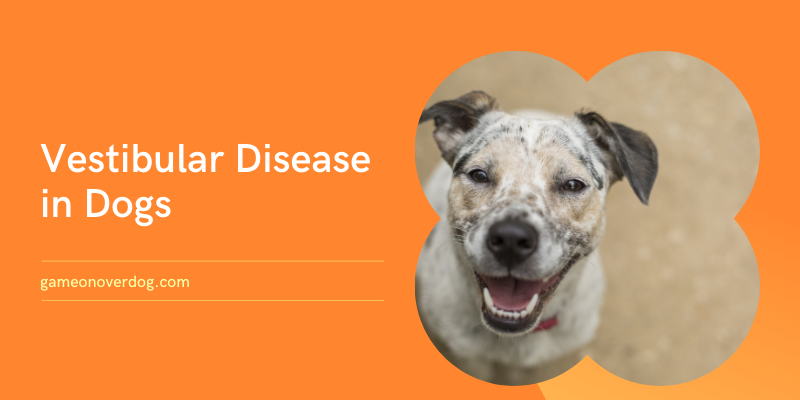What is Vestibular Disease in Dogs? – Learn About Vestibular Disease and the Symptoms
Vestibular disease (VD) is a common, often silent cause of sudden, severe, and progressive loss of balance. The vestibular system is the inner ear system that helps the body keep balance. When the vestibular system goes haywire, a dog experiences dizziness and extreme nystagmus (rapid involuntary head movements).
Is vestibular Disease in Dogs Contagious?
Vestibular disease can occur at any age, but most cases are seen in older dogs. It is more common in purebred dogs but can affect any breed or mix. It is thought that VD occurs due to trauma to the inner ear (i.e., a shake or bump) which triggers an immune response by the body’s repair mechanisms. This causes inflammation and scarring of the inner ear causing it to lose its ability to sense balance even though there may be no outward sign of VD.
Can Vestibular Disease Be Treated?
Unfortunately, there is no cure for the vestibular disease. Your dog’s symptoms improve because the inner ear has healed. This is why dogs will show better balance as the inner ear heals.
However, the disease can be managed, and the progression of the loss of balance is slowed with medication and physical therapy.
Many dogs will also experience a significant improvement in their balance after they have been diagnosed by an ear, nose, and throat (ENT) specialist. An ENT specialist can identify the problem and recommend the right treatments to manage the symptoms.
Symptoms of Vestibular Disease in Dogs VD cause various symptoms, including dizziness, visual disturbances (especially blurred vision), lack of balance, and difficulty walking.
Many dogs experience only one or two of these symptoms. However, some dogs experience multiple symptoms and some experience none. The severity and progression of the symptoms depend on the underlying cause of vestibular disease.
What causes vestibular disease in dogs?
There are many potential causes of vestibular disease. The most common cause is trauma or damage to the inner ear from shaking or bumping the head.
Trauma can occur when a dog hits his head or is accidentally injured. Damage during pregnancy or early in life (before week 6) is also considered a cause.
Autoimmune inner ear inflammation is a less common but severe cause of vestibular disease. Some medications can also cause VD. These include antibiotics (especially cephalosporin), NSAIDs, antihistamines, and steroids.
And there have been some reported cases of VD that started after a dog had a blood test for a vestibular disorder.
Diagnosis of Vestibular Disease in Dogs
If you have noticed poor balance in your dog, a check-up with your veterinarian is a good idea. Your doctor will likely perform a thorough clinical exam of your dog, looking for external signs of injury or infection.
In addition, an examination of your dog’s hearing, eyes, and balance will be conducted. The doctor will likely order a series of tests to rule out other disorders before making a definitive diagnosis.
These tests include an electroencephalogram (EEG), a test that records the electrical activity in your dog’s brain; a magnetic resonance imaging (MRI) of your dog’s brain; and a cerebrospinal fluid (CSF) test that measures the volume of cerebrospinal fluid in your dog’s spinal cord.
Vestibular Disorder and Vestibulitis Treatment
Your veterinarian can prescribe medication (e.g., anti-inflammatory drugs) to help manage vestibular disorder symptoms. In some cases, a vestibular disorder can be surgically corrected.
This often involves removing a portion of the skull (i.e., a craniectomy) and placing a complex hat-like device over the ear canal called a tympanostomy tube.
Following Up on Vestibular Disorder and Vestibulitis Treatment
Following up on vestibular disorder and vestibulitis Treatment is essential to keep your dog comfortable. As your dog heals, you can help manage the inflammation by applying an ice pack to your dog’s ear every hour and applying analgesic ointment to your dog’s skin.
Following this, your dog will need to rest his head. Avoid exercise that involves your dog jumping and running.
Conclusion
VD is a severe condition that affects the inner ear. It can be a scary disorder in your dog and causes various symptoms, including dizziness, blurred vision, and loss of balance. Your vet can diagnose VD, help manage the symptoms, and guide you on how to manage your dog’s recovery.
Can a dog die from vestibular disease?
You should consult your vet if you suspect your dog may have vestibular disease.
What is vestibular disease? Vestibular disease is a condition of the inner ear that affects dogs. It is caused by damage to the inner ear hair cells (cilia) or nerve endings.
The affected cilia are located near the back of the ears and are responsible for two main functions: hearing and balance. Hearing helps us understand what is around us, while balance keeps us upright when walking on uneven ground or standing in a tilted position.
Vestibular disease can affect dogs in many different ways. It can be diagnosed using a variety of tests, including x-rays of the head, an examination of the ears with a particular instrument called an otoscope, and an ultrasound examination of the brain, which measures brain function. There are three types of vestibular disease in dogs:
1) Labyrinthine Disease This condition may start as early as four weeks after birth and can last for several years before it disappears completely.
It affects both hearing and balance in its earliest stages. Still, it does not affect vision until later when the dog’s eyesight deteriorates further from lack of eye-gaze movement control on one side (abducens nerve weakness).
The dog may also have difficulty rising from a sitting position because his hind legs are not as strong as his front legs. In most cases, this condition is temporary due to changes in diet, drugs
